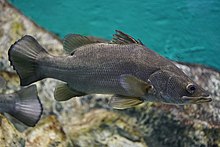ปลากะพงแม่น้ำไนล์
| ปลากะพงแม่น้ำไนล์ | |
|---|---|

| |
| สถานะการอนุรักษ์ | |
| การจำแนกชั้นทางวิทยาศาสตร์ | |
| โดเมน: | ยูแคริโอต Eukaryota |
| อาณาจักร: | สัตว์ Animalia |
| ไฟลัม: | สัตว์มีแกนสันหลัง Chordata |
| ชั้น: | ปลาที่มีก้านครีบ Actinopterygii |
| อันดับ: | อันดับปลากะพง Perciformes |
| วงศ์: | วงศ์ปลากะพงขาว Latidae |
| สกุล: | ปลากะพงขาว (สกุล) Lates (Linnaeus, 1758) |
| สปีชีส์: | Lates niloticus |
| ชื่อทวินาม | |
| Lates niloticus (Linnaeus, 1758) | |
| ชื่อพ้อง | |
| |
ปลากะพงแม่น้ำไนล์ (อังกฤษ: Nile perch, African snook; ชื่อวิทยาศาสตร์: Lates niloticus) หรือชื่อในภาษาพื้นเมืองว่า อิมพิวทา (Imputa)[2] เป็นปลาน้ำจืดขนาดใหญ่ อยู่ในวงศ์ปลากะพงขาว (Latidae) มีรูปร่างคล้ายปลากะพงขาว (L. calcarifer) ซึ่งเป็นปลาอยู่ในวงศ์เดียวกัน สกุลเดียวกัน ต่างกันที่ปลากะพงแม่น้ำไนล์มีครีบหลังที่ยกสูงกว่า และมีขนาดตัวเมื่อโตเต็มที่ได้ใหญ่กว่ามาก โดยยาวได้ถึง 2 เมตร หนักได้ถึง 200 กิโลกรัม หนักสุดพบ 230 กิโลกรัม จัดเป็นปลาที่มีความใหญ่ที่สุดในวงศ์นี้
อาศัยอยู่ในแม่น้ำไนล์ ในทวีปแอฟริกา พบในอียิปต์, ชาด, เซเนกัล, คองโก, เคนยา เป็นต้น นิยมตกเป็นเกมกีฬา โดยถูกจัดให้เป็นปลาที่สามารถตกด้วยเบ็ดได้ที่ใหญ่ที่สุดในโลก ใช้เนื้อบริโภคเป็นอาหารขึ้นชื่อในท้องถิ่น และส่งออกต่างประเทศ เช่น ญี่ปุ่น เป็นต้น
นอกจากนี้ยังนิยมเลี้ยงเป็นปลาสวยงามด้วย ด้วยความใหญ่ในรูปร่าง ในแง่ของปัญหาสิ่งแวดล้อม ปลากะพงแม่น้ำไนล์ถือเป็นชนิดพันธุ์ต่างถิ่นที่คุกคามสิ่งมีชีวิตชนิดอื่น ๆ ในทะเลสาบแทนกันยีกาและทะเลสาบวิกตอเรีย โดยเพาะอย่าง ปลาในวงศ์ปลาหมอสี (Cichlidae) เพราะเป็นปลาขนาดใหญ่ที่กินปลาและสัตว์น้ำชนิดอื่นที่เล็กกว่าเป็นอาหาร และกินเป็นจำนวนมาก จึงเป็นต้นเหตุที่ทำให้หลายชนิดต้องอยู่ในภาวะใกล้สูญพันธุ์ เพราะปลากะพงแม่น้ำไนล์มิได้เป็นปลาพื้นถิ่นของทะเลสาบทั้งสองแห่งนี้ แต่ทว่าถูกนำไปปล่อยโดยเมื่อทศวรรษที่ 50[3]
รูปภาพ
[แก้]-
ภาพวาดลูกปลาวัยอ่อน
-
ส่วนหัว
-
เนื้อปลาเมื่อถูกแล่แล้ว
อ้างอิง
[แก้]- ↑ Azeroual, A.; Entsua-Mensah, M.; Getahun, A.; Lalèyè, P.; Moelants, T. & Ntakimazi, G. (2018) [errata version of 2018 assessment]. "Lates niloticus". IUCN Red List of Threatened Species. 2018: e.T181839A125152154. doi:10.2305/IUCN.UK.2010-3.RLTS.T181839A7746967.en. สืบค้นเมื่อ 22 February 2020.
- ↑ [https://web.archive.org/web/20081122043513/http://www.unep.ch/etu/etp/acts/capbld/rdone/uganda.pdf เก็บถาวร 2008-11-22 ที่ เวย์แบ็กแมชชีน ข้อมูลดาวน์โหลด]
- ↑ Lake Victoria: a sick giant
อ่านเพิ่ม
[แก้]- Beuving, J. J. 2010. "Playing pool along the shores of Lake Victoria. Fishermen, careers and capital accumulation in the Ugandan Nile perch business" Africa: Journal of the International African Institute 80 (2): 224–248.
- Beuving, J. J. 2013. "Chequered Fortunes in Global Exports: The Sociogenesis of African Entrepreneurship in the Nile Perch Business at Lake Victoria, Uganda" doi:10.1057/ejdr.2013.28
- Pringle, R.M. 2005. "The origins of the Nile perch in Lake Victoria." BioScience 55:780-787. doi:10.1641/0006-3568(2005)055[0780:TOOTNP2.0.CO;2]
- Pringle, R.M. 2005. "The Nile Perch in Lake Victoria: local responses and adaptations." Africa 75:510-538. doi:10.3366/afr.2005.75.4.510
- Masciarelli, Alex. "The rise and fall of the Nile Perch." March 15, 2007. [1]
- Socio-economic effects of the evolution of Nile perch fisheries in Lake Victoria: a review. J. Eric Reynolds and D.F. Greboval, CIFA Technical paper 17, FAO 1988, ISBN 92-5-102742-0 (online version)
- M.L. Bianchini (1995). Species introductions in the aquatic environment: changes in biodiversity and economics of exploitation. Proc. World Fish. Congress (Athens, 1992), 3: 213–222.
แหล่งข้อมูลอื่น
[แก้]- Froese, Rainer and Pauly, Daniel, eds. (2004). "Lates niloticus" in FishBase. October 2004 version.
- "Lates niloticus". ระบบข้อมูลการจำแนกพันธุ์แบบบูรณาการ. สืบค้นเมื่อ 20 December 2004.
- Lipton, David. "Lates niloticus: Information". Animal Diversity Web. Ann Arbor: University of Michigan Museum of Zoology, 2003.
- Snoeks, Jos. "Ecology of Lates niloticus". Global Invasive Species Database. Updated 22 September 2004.
- IUCN. "Alien Species Invade the Planet". Press release, 11 May 2001.
- Species Profile - Nile Perch (Lates niloticus), National Invasive Species Information Center, United States National Agricultural Library.




